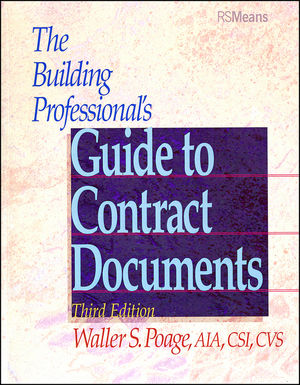The Building Professional's Guide to Contracting Documents, 3rd EditionISBN: 978-0-87629-577-9
Paperback
393 pages
December 2000
 This is a Print-on-Demand title. It will be printed specifically to fill your order. Please allow an additional 10-15 days delivery time. The book is not returnable.
|
||||||
ACKNOWLEDGMENTS.
INTRODUCTION.
CHAPTER ONE: THE CONSTRUCTION INDUSTRY.
The OPC Relationship.
The Owner.
The Design Professional.
The Constructor.
The Subcontractor.
The Sub-Subcontractor.
The Producer.
The Product Representative.
The Building Official.
Building Codes.
Industry Services.
Industry Influences.
Summary.
CHAPTER TWO: THE OWNER.
The Economy of the United States.
The Private Sector Owner.
Private Sector Finance.
The Public Sector Owner.
Public Sector Finance.
CHAPTER THREE: THE DESIGN PROFESSIONAL.
Professional Practice.
The Architect.
The Interior Designer.
The Engineer.
Professional Institutions.
Methods of Practice.
Professional Compensation.
Selecting the Design Professional.
Primary Responsibilities of the Design Professional.
A Word on Perfection.
CHAPTER FOUR: THE CONSTRUCTOR.
The Business of Building Construction.
Training and Qualifications.
Financial Concerns.
Legal Concerns.
The Contract Price.
Summary.
CHAPTER FIVE: LABOR AND GOVERNMENT.
The History and Influence of Labor.
The Influence of Government.
CHAPTER SIX: LEGAL CONCERNS AND INSURANCE.
Development of Law.
Private Law.
Law and the Construction Industry.
Statutes of Limitation.
Risk Management.
Insurance for the Construction Industry.
History and Development of Insurance.
Insurance Today.
Bonds.
Settlement of Disputes.
Summary.
CHAPTER SEVEN: PROJECT DELIVERY.
Factors that Drive the Owner’s Decision.
Value Engineering.
Partnering in the Project Delivery Process.
The Advent of Construction Management.
The Advent of Program Management.
Project Delivery Alternatives.
Traditional Method (Design/Bid/Build).
Design/Multiple-Bid/Build Project Delivery.
Construction Management Project Delivery.
Program Management Project Delivery.
Design/Build Project Delivery.
Competitive Selection of the Design/Build Team.
Financial Risk.
Risks to the Owner.
Risks of the Design Professional.
Risks of the Constructor.
CHAPTER EIGHT: THE CONSTRUCTION CONTRACT.
Contracts Defined.
Agreement Between Owner and Contractor.
Components of the Contract Documents.
Types of Contracts.
Single Prime Contracts.
Multiple Prime Contracts—Construction Management Contracts.
Turn-Key Contracts.
Design/Build Contracts.
Methods of Payment.
Definition of “Lump Sum” Contracts.
Unit Cost Contracts.
Cost of Work Plus a Fee.
Guaranteed Maximum Price (GMP) Contracts.
Bonus and Penalty Provisions.
Liquidated Damages.
Profit Sharing Provisions.
Summary.
CHAPTER NINE: CONDITIONS OF THE CONTRACT.
The Evolution of Standardized Documents.
AIA General Conditions.
EJCDC Conditions.
Owner-Generated Conditions of the Contract.
Contractual Relationships.
Advice of Legal Counsel.
Writing Conditions of the Contract.
Supplements to Contract Conditions.
Conditions of the Contract.
Modification Documents.
Contractor’s Review of Contract Documents and Field Conditions.
Administration of the Contract for Construction.
Construction by Owner or Separate Contractor.
Making Changes in the Work.
Defining Time and Establishing “Milestones”.
Schedule of Values.
Protection of Persons and Property.
Requirements for Insurance and Bonds.
Miscellaneous Provisions.
Defining Termination or Suspension of the Contract.
CHAPTER TEN: PROJECT DEFINITION.
Engineering and Architectural Graphics.
Reproduction of Drawings.
“Working Drawings”.
Organizing the “Set” of Construction Drawings.
Systems Production of Drawings.
Overlay Drafting.
Computer Aided Design and Drafting.
Three-Dimensional and Perspective Drawings by CAD.
The Personal Computer—The Design Professional’s Tool of Choice.
Graphic Standards.
Schedules.
Related Drawings and Specifications.
Preparation of Specifications.
Specification Language.
The Three-Part Section Format.
Part 1—General.
Part 2—Products.
Part 3—Execution.
Page Format.
The 16 Divisions.
Methods of Specifying.
Specifying Techniques.
Testing Materials and Systems.
Disputes.
The “Master” Specification.
The “Outline” Specification.
Summary.
CHAPTER ELEVEN: THE PROJECT MANUAL.
Invitation to Bid.
Instruction to Bidders.
Conditions of the Contract.
Specifications.
Creating the Project Manual.
The Specification Writer.
Documents Associated with the Project Manual.
Industry Resources.
CHAPTER TWELVE: CONTRACT ADMINISTRATION.
The Function of Government.
Taxation and Fees.
The OPC Relationship—Duties and Objectives.
Project Meetings.
Transmittals.
Submittals.
Shop Drawings.
Schedules.
Mock-Ups.
Requests and Certificates for Payment.
Substantial Completion.
Project Closeout.
Certificate of Occupancy.
CHAPTER THIRTEEN: PROJECT RECORD-KEEPING AND CLOSE-OUT.
The Record-Keeping Process.
Pre-Construction Submittals.
Construction Submittals.
Construction Records.
Modifications to the Contract.
Close-Out Documents.
Beneficial Occupancy.
Summary.
APPENDIX.
GLOSSARY OF TERMS.
INDEX



